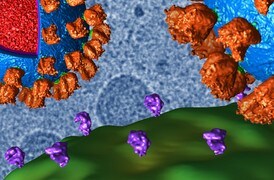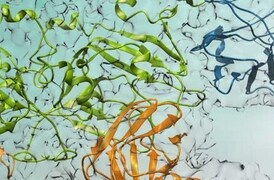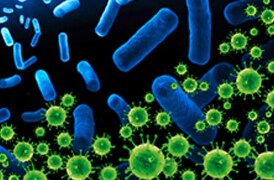Search Thermo Fisher Scientific
Available on Thermo Scientific Krios and Glacios Cryo-TEMs, the Thermo Scientific Selectris and Selectris X Imaging Filters are post-column imaging filters that improve the contrast of TEM images, resulting in high-resolution structures up to atomic resolution. The zero-loss filtering of the Selectris Filters removes noise caused by inelastically scattered electrons, producing an increased signal-to-noise ratio (SNR) and better contrast. Designed for high stability, the zero-loss peak position of the Selectris Filters has minimized sensitivity to temperature variations in the environment, eliminating the need for frequent tuning.
With the Selectris Filters, zero-loss energy filtering is straightforward due to the thorough integration of software and hardware along with extensive automation and exceptional stability. Every mechanical and electron-optical element has been designed for stability and data reproducibility, enabling the unattended and reliable acquisition of large datasets with narrow energy slit widths (<10 eV). The capability to use these narrow slit widths provides an additional boost in contrast for single particle cryo-electron microscopy (cryo-EM), enhancing signal strength, resolution, and throughput.
Paired with the latest generation Thermo Scientific Falcon 4i Direct Electron Detector, Selectris Filters allow you to obtain high-resolution structures quickly, revealing new biological insights. Incorporated Falcon 4i camera with electron event representation (EER) enables efficient file size compression, super-resolution capabilities and maximized sensitivity for all use cases. To further increase the productivity and ease-of-use of your cryo-EM workflows for single particle analysis and cryo-electron tomography, these filters are fully integrated into Thermo Scientific EPU Software, Thermo Scientific Tomography Software, and our instrument operation software.

Selectris X Filter – taking the next step toward atomic resolution
The Selectris X was designed for researchers seeking industry-leading optical performance, while the Selectris is ideal for those who require maximum efficiency and throughput. Expanding on the stability, ease-of-use, and performance of the Selectris platform, the Selectris X Imaging Filter offers an even more sophisticated electron optical system for further aberration correction. This results in extremely low distortion characteristics in both the image and energy domains, opening the way to true atomic-resolution structures.
How energy-filtering transmission electron microscopy works
Upon interacting with the sample, electrons may scatter elastically or inelastically. The Selectris Imaging Filter allows elastically scattered electrons to pass through, thereby enhancing image contrast. The intrinsic mechanism is that through removing the noise caused by inelastically scattered electrons, the signal-to-noise ratio (SNR) and the contrast is increased.
The capability to use a very stable narrow slit width (<10 eV) provides an additional boost in contrast for single particle cryo-electron microscopy (cryo-EM) and cryo-tomography (cryo-ET), also enhancing resolution and throughput.
For example, let’s compare reconstructions of proteasome 20S with the same amount of particles (see table). A narrower energy slit (i.e. lower energy) leads to higher resolution compared to a larger slit width (20 keV) and even more improved compared to unfiltered image. This is because the B-factor has been reduced meaning less particles are needed to obtain a certain resolution.
Additionally, a narrower energy slit width (10 eV) translates into a lesser number of particles needed to obtain equivalent resolution (370k) compared to using a wider energy slit (see figure and graph). As a result, with the Selectris X Imaging Filter, you can obtain results faster with less data or maximize your resolution efforts.

Experiment | # Particles | Resolution (Å) | B-factor |
| 10 eV | 102,200 | 2.14 | 89.3 |
| 20 eV | 102,200 | 2.26 | 99.5 |
| Unfiltered | 102,200 | 2.34 | 106.1 |


Getting to lower energy slit widths, such as 5 or 10 eV, requires a very stable filter to avoid interruptions for filter alignment.
“We’re impressed with the stability of both the hardware and the software. Due to the enhanced performance and stability, all our COVID-19 work is now done on the Selectris X Imaging Filter. We routinely collect 5 eV tomograms, which was previously impossible.”
Alistair Siebert, Principal Electron Microscopist for the electron Bio-Imaging Centre (eBIC), Diamond Light Source


"The Selectris X Imaging Filter is clearly favored by us due to its stability and robustness, particularly when it comes to data collection for cryo-EM and cryo-ET that is carried out over extended periods of time. Once tuned, the filter is stable for over a month. The zero loss peak only moves by 1 eV over a week or even two!”
Dr. Juergen Plitzko, Max Planck Institute for Biochemistry, Martinsried Germany
What's possible with Selectris at 200 kV and 300 kV
Selectris and Selectris X Imaging Filters are fully compatible with Glacios Cryo-TEM, featuring 200 kV XFEG optics. The Glacios Cryo-TEM bundles all this into a small footprint that simplifies installation.


Designed for stability
- Narrow (<10 eV) zero-loss energy filtering offers enhanced contrast for higher resolution reconstructions
- Sophisticated aberration correction, low image distortions, and uniform energy resolution over entire field of view
- Minimized sensitivity to temperature variations
Straightforward operation
- Fully integrated with Thermo Scientific instrument operation software, as well as EPU Software and Tomography Software for data collection.
- Automated filter tuning completed in minutes
- No need to interrupt data collection for zero-loss centering
Falcon 4i Direct Electron Detector
- Unsurpassed image quality through higher DQE
- Large pixels with high signal-to-noise ratio (SNR)
- Higher throughput for more images per hour
- Lossless data compression with electron event representation (EER)
Fast, infrequent tuning
- Tuning can be completed automatically within minutes, on the rare occasion that filter tuning is necessary
- Experimental runs without interruption, for smooth daily operation and efficient data collection
| |
| Position | Bottom mounted |
| Stability | Slit drift <± 1.5eV/24hr |
| Zero-loss centering | Automated |
| Filter tuning | Automated |
| TEM operating voltage | 200 kV, 300 kV |
| |
| Sensor | 4,096 × 4,096 pixels, ~ 5.7 x 5.7 cm |
| Pixel size | 14 x 14 um2 pixel size |
| File formats |
|
| Detection modes |
|
| Automation |
|
Apoferritin resolved at 1.7 Å using 10 eV filtering on the Glacios Cryo-TEM with Selectris X.
GABA-A receptor human membrane protein resolved at 2.4 Å (~200 kDa) with 94k particles compared to 2.8 Å resolution and 127k on an unfiltered sample by the Glacios Cryo-TEM with Selectris X. Sample courtesy of MRC-LMB Cambridge.
Human hemoglobin (small molecule, 64 kDa) resolved at 3.4 Å with the Glacios Cryo-TEM with Selectris X.

Cryo-EM: What's Next
Register to view on-demand presentations covering the Selectris capabilities, a behind-the-scenes look at R&D filter development, and record-breaking structure resolution results for single particle analysis and cellular cryo-tomography using the Selectris Filter. Learn about the potential applications with high resolution for small proteins (<100kDa), proper model building and corrected chemistries.
Press
Nature News, Cryo-electron microscopy reaches atomic resolution. 21 October 2020
Science News, Cryo–electron microscopy breaks the atomic resolution barrier at last. 21 October 2020
Lowe, Derek. Down to the Atoms, Science Translational Medicine. 30 October 2020
Nature News, 2020 beyond COVID: the other science events that shaped the year. 14 December 2020
Apoferritin resolved at 1.7 Å using 10 eV filtering on the Glacios Cryo-TEM with Selectris X.
GABA-A receptor human membrane protein resolved at 2.4 Å (~200 kDa) with 94k particles compared to 2.8 Å resolution and 127k on an unfiltered sample by the Glacios Cryo-TEM with Selectris X. Sample courtesy of MRC-LMB Cambridge.
Human hemoglobin (small molecule, 64 kDa) resolved at 3.4 Å with the Glacios Cryo-TEM with Selectris X.

Cryo-EM: What's Next
Register to view on-demand presentations covering the Selectris capabilities, a behind-the-scenes look at R&D filter development, and record-breaking structure resolution results for single particle analysis and cellular cryo-tomography using the Selectris Filter. Learn about the potential applications with high resolution for small proteins (<100kDa), proper model building and corrected chemistries.
Press
Nature News, Cryo-electron microscopy reaches atomic resolution. 21 October 2020
Science News, Cryo–electron microscopy breaks the atomic resolution barrier at last. 21 October 2020
Lowe, Derek. Down to the Atoms, Science Translational Medicine. 30 October 2020
Nature News, 2020 beyond COVID: the other science events that shaped the year. 14 December 2020

構造生物学研究
クライオ電子顕微鏡法により、巨大複合体や柔軟な分子種、膜タンパク質など、解析が困難な生体試料の構造を解析できます。

創薬
多くの主要な医薬品候補群について合理的薬物設計を行い、最高レベルの医薬品を開発する方法をご覧ください。

感染症研究
クライオ電子顕微鏡技術により、さまざまなスケールの3D生体構造が自然に近い状態で観察できるようになり、より迅速かつ効率的な医薬品開発を促進しています。

単粒子解析法
単粒子解析法(SPA)はクライオ電子顕微鏡法のひとつであり、原子分解能に近い構造解析が可能で、ダイナミックな生物学的プロセスおよび生体分子複合体/アセンブリの構造を明らかにします。

クライオトモグラフィー
クライオ電子線トモグラフィー(cryo-ET)を用いれば、個々のタンパク質の構造情報と細胞内の空間的な位置関係の両方を明らかにできます。これはcryo-ET特有の機能であり、この機能により、cryo-ETは細胞生物学における大きな可能性を秘めています。Cryo-ETは光学顕微鏡法と、単粒子解析法などの原子レベルに近い分解能を達成する手法とを橋渡しする技術です。

統合構造生物学
タンパク質の機能を理解するためには、個々のタンパク質だけではなく、タンパク質複合体の構造情報も理解することが必要です。統合構造生物学では、質量分析法とクライオ電子顕微鏡法を組み合わせ、大規模なタンパク質複合体の動的構造を把握できます。

単粒子解析法
単粒子解析法(SPA)はクライオ電子顕微鏡法のひとつであり、原子分解能に近い構造解析が可能で、ダイナミックな生物学的プロセスおよび生体分子複合体/アセンブリの構造を明らかにします。

クライオトモグラフィー
クライオ電子線トモグラフィー(cryo-ET)を用いれば、個々のタンパク質の構造情報と細胞内の空間的な位置関係の両方を明らかにできます。これはcryo-ET特有の機能であり、この機能により、cryo-ETは細胞生物学における大きな可能性を秘めています。Cryo-ETは光学顕微鏡法と、単粒子解析法などの原子レベルに近い分解能を達成する手法とを橋渡しする技術です。

統合構造生物学
タンパク質の機能を理解するためには、個々のタンパク質だけではなく、タンパク質複合体の構造情報も理解することが必要です。統合構造生物学では、質量分析法とクライオ電子顕微鏡法を組み合わせ、大規模なタンパク質複合体の動的構造を把握できます。
Related Products
ライフサイエンス向けの
電子顕微鏡サービス
最適なシステム性能をお届けするため、当社は国際的なネットワークで、分野ごとのサービスエキスパート、テクニカルサポート、正規交換部品などを提供しています。















